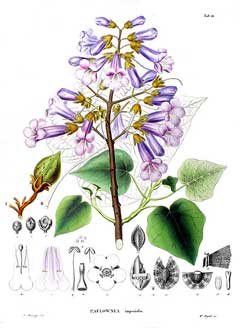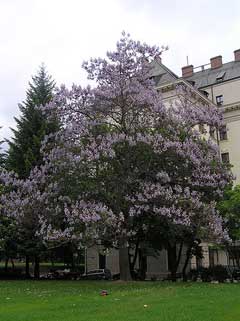 |
|
http://commons.wikimedia.org/wiki/File:Paulowni_imperialis_SZ10.jpg |
 |
| http://commons.wikimedia.org/wiki/User:Don_Pedro28 |
Translate this page:
Summary
Bloom Color: Lavender. Main Bloom Time: Early spring, Late spring, Mid spring. Form: Rounded, Vase.
Physical Characteristics

 Paulownia is a deciduous Tree growing to 15 m (49ft) by 10 m (32ft) at a fast rate.
Paulownia is a deciduous Tree growing to 15 m (49ft) by 10 m (32ft) at a fast rate.
See above for USDA hardiness. It is hardy to UK zone 5 and is not frost tender. It is in flower in May, and the seeds ripen from September to October. The species is hermaphrodite (has both male and female organs). The plant is self-fertile.
Suitable for: light (sandy), medium (loamy) and heavy (clay) soils and prefers well-drained soil. Suitable pH: mildly acid, neutral and basic (mildly alkaline) soils. It cannot grow in the shade. It prefers moist soil. It can tolerate atmospheric pollution.
UK Hardiness Map
US Hardiness Map
Synonyms
P. imperialis. Sieb.&Zucc. P. recurva. Bignonia tomentosa.
Plant Habitats
Edible Uses
Leaves - cooked. An emergency food, used when all else fails[177, 183]. Flowers[177]. Eaten with miso[183].
References More on Edible Uses
Medicinal Uses
Plants For A Future can not take any responsibility for any adverse effects from the use of plants. Always seek advice from a professional before using a plant medicinally.
A decoction of the leaves is used to wash foul ulcers and is also said to promote the growth of hair and prevent greying[218, 222]. The leaves are also poulticed onto bruises[218]. The leaf juice is used in the treatment of warts[218, 222]. The flowers are used in the treatment of skin ailments[178, 218]. A tincture of the inner bark is used in the treatment of fevers and delirium[218]. It is astringent and vermifuge[178, 218].
References More on Medicinal Uses
The Bookshop: Edible Plant Books
Our Latest books on Perennial Plants For Food Forests and Permaculture Gardens in paperback or digital formats.

Edible Tropical Plants
Food Forest Plants for Hotter Conditions: 250+ Plants For Tropical Food Forests & Permaculture Gardens.
More

Edible Temperate Plants
Plants for Your Food Forest: 500 Plants for Temperate Food Forests & Permaculture Gardens.
More

More Books
PFAF have eight books available in paperback and digital formats. Browse the shop for more information.
Shop Now
Other Uses
Wood - not attacked by insects. Used for making boxes, clogs, furniture, musical instruments etc. Good for posts and beams in construction[46, 61, 151, 178]. A source of charcoal[46, 61].
Special Uses
References More on Other Uses
Cultivation details
Landscape Uses:Firewood, Pest tolerant, Aggressive surface roots possible, Specimen. Requires a deep moderately fertile moisture retentive but well-drained soil in a sunny sheltered position[11, 200]. Plants are tolerant of atmospheric pollution[200]. A very ornamental and fast growing plant[11]. The flower buds are formed in autumn and can be excited into premature growth during mild winter weather, this growth is then more susceptible to frost damage[1, 11]. The flower buds are hardy to about -15°c when dormant[200]. Plants, and especially seedlings less than 2 years old, are frost tender when young[11, 200]. They do not flower reliably in maritime zones, this is probably due to insufficient warmth and dryness in the summer[200]. Branches tend to be brittle[200]. The flowers have a delicate sweet fragrance[245]. Trees can be coppiced annually, they will then produce very vigorous growth with leaves up to 1 metre wide[11]. Plants in this genus are notably resistant to honey fungus[200]. Special Features:Not North American native, Invasive, Naturalizing, Blooms are very showy.
References Carbon Farming Information and Carbon Sequestration Information
Temperature Converter
Type a value in the Celsius field to convert the value to Fahrenheit:
Fahrenheit:
The PFAF Bookshop
Plants For A Future have a number of books available in paperback and digital form. Book titles include Edible Plants, Edible Perennials, Edible Trees,Edible Shrubs, Woodland Gardening, and Temperate Food Forest Plants. Our new book is Food Forest Plants For Hotter Conditions (Tropical and Sub-Tropical).
Shop Now
Plant Propagation
Seed - best sown as soon as it is ripe in a cold frame[200]. Sow stored seed in late winter in a greenhouse at 15 - 20°c[78]. The seed requires light for germination[200]. Fair to good germination. When they are large enough to handle, prick the seedlings out into individual pots and grow them on in the greenhouse for their first winter. Plant them out into their permanent positions in late spring or early summer, after the last expected frosts. Cuttings of half-ripe wood, 5 - 8cm with a heel, July/August in a frame. Overwinter in a cold frame for its first year and plant out in late spring[200]. Root cuttings 4cm long in December. Good percentage[78].
Other Names
If available other names are mentioned here
Native Range
TEMPERATE ASIA: China (Anhui Sheng, Gansu Sheng, Hebei Sheng, Henan Sheng, Hubei Sheng, Hunan Sheng, Jiangsu Sheng, Jiangxi Sheng, Liaoning Sheng (south), Shaanxi Sheng, Shandong Sheng, Shanxi Sheng, Sichuan Sheng (north))
Weed Potential
Right plant wrong place. We are currently updating this section.
Please note that a plant may be invasive in one area but may not in your area so it's worth checking.
Conservation Status
IUCN Red List of Threatened Plants Status :

Growth: S = slow M = medium F = fast. Soil: L = light (sandy) M = medium H = heavy (clay). pH: A = acid N = neutral B = basic (alkaline). Shade: F = full shade S = semi-shade N = no shade. Moisture: D = dry M = Moist We = wet Wa = water.
Now available:
Food Forest Plants for Mediterranean Conditions
350+ Perennial Plants For Mediterranean and Drier Food Forests and Permaculture Gardens.
[Paperback and eBook]
This is the third in Plants For A Future's series of plant guides for food forests tailored to
specific climate zones. Following volumes on temperate and tropical ecosystems, this book focuses
on species suited to Mediterranean conditions—regions with hot, dry summers and cool, wet winters,
often facing the added challenge of climate change.
Read More
Expert comment
Author
(Thunb.)Steud.
Botanical References
11200266
Links / References
For a list of references used on this page please go here
Readers comment
| Add a comment |
|
If you have important information about this plant that may help other users please add a comment or link below. Only comments or links that are felt to be directly relevant to a plant will be included. If you think a comment/link or information contained on this page is inaccurate or misleading we would welcome your feedback at [email protected]. If you have questions about a plant please use the Forum on this website as we do not have the resources to answer questions ourselves.
* Please note: the comments by website users are not necessarily those held by PFAF and may give misleading or inaccurate information.
To leave a comment please Register or login here All comments need to be approved so will not appear immediately.
|
|